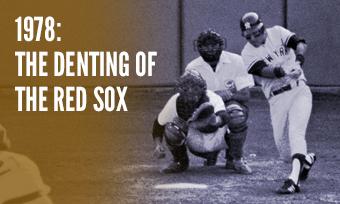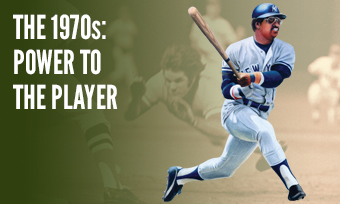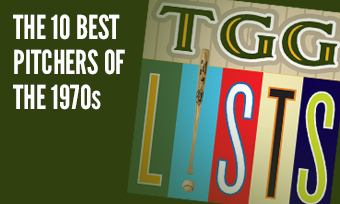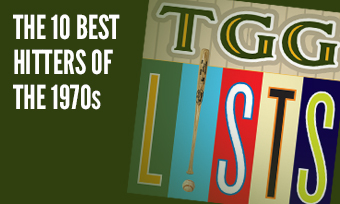The Yearly Reader
Leaders and Honors, 1978
Our list of baseball’s top 10 hitters and pitchers in both the American League and National League for the 1978 baseball season, as well as the awards and honors given to the game’s top achievers of the year.
The National League’s Top 10 Hitters, 1978
Bold type in brick red indicates league leader.
1. Dave Parker, Pittsburgh
Key Numbers: .334 average, 102 runs, 194 hits, 32 doubles, 12 triples, 30 home runs, 117 RBI, 23 intentional walks, 20 stolen bases, .585 slugging percentage.
Parker checked in as the NL’s titan in size and performance, the lumbering Pirate gradually improving until he was virtually unstoppable in the home stretch—hitting .426 over his last 38 games.
2. George Foster, Cincinnati
Key Numbers: .281 average, 97 runs, 170 hits, 26 doubles, 7 triples, 40 home runs, 120 RBIs.
Following his monster 1977 performance, Foster’s numbers eased off but were weighed in at heavyweight levels; he led the NL for the third straight year in RBIs, averaging 130 per year from 1976-78.
3. Jack Clark, San Francisco
Key Numbers: .306 average, 90 runs, 181 hits, 46 doubles, 8 triples, 25 home runs, 98 RBIs, 15 stolen bases.
The young outfielder represented a new breed of Giants hitters in front of a re-engaged (and much larger) fan base at Candlestick Park; his 26-game hit streak was the NL’s second longest of the season, after Pete Rose’s record-tying 44-game run.
4. Greg Luzinski, Philadelphia
Key Numbers: .265 average, 85 runs, 32 doubles, 35 home runs, 101 RBIs, 100 walks, 11 hit-by-pitches.
In his last savagely good year with the Phillies, Luzinski saw his average drop well below the .300 mark it had been for three years, but made up for it on-base-wise with a career-high 100 walks.
5. Reggie Smith, Los Angeles
Key Numbers: 128 games, .295 average, 82 runs, 27 doubles, 29 home runs, 93 RBIs, 12 stolen bases, 13 sacrifice flies.
A series of injuries was all that kept Smith from topping his terrific numbers of a year before.
6. Dave Winfield, San Diego
Key Numbers: .308 average, 88 runs, 181 hits, 30 doubles, 5 triples, 24 home runs, 97 RBIs, 20 intentional walks, 21 stolen bases.
Winfield, who spurned offers to play in the NFL and NBA, finally emerged to superstar status after years of steady growth.
7. Steve Garvey, Los Angeles
Key Numbers: 162 games, .316 average, 89 runs, 202 hits, 36 doubles, 9 triples, 21 home runs, 113 RBIs, 10 stolen bases.
A .434 clip in September helped Garvey clinch his fourth 200-hit campaign, the first time he led the NL in that category.
8. Jose Cruz, Houston
Key Numbers: .315 average, 79 runs, 178 hits, 34 doubles, 9 triples, 10 home runs, 83 RBIs, 37 stolen bases.
Cruz was slowly but surely developing into one of the biggest threats on an Astros team that relied less and less on power.
9. Jeff Burroughs, Atlanta
Key Numbers: .301 average, 30 doubles, 6 triples, 23 home runs, 77 RBIs, 117 walks, .432 on-base percentage.
Although Burroughs’ power production dropped from the 41 home runs he slammed the year before, it wasn’t the fault of his home park; 19 of his 23 dingers came at Atlanta-Fulton County Stadium.
10. Willie Stargell, Pittsburgh
Key Numbers: 122 games, .295 average, 28 home runs, 97 RBIs.
Like MVP teammate Dave Parker above, a revitalized 38-year-old Stargell finished hot for the Bucs—batting .326 with 12 homers and 41 RBIs over his final 35 games played. Pops would carry that momentum into his own MVP effort a year later.
The American League’s Top 10 Hitters, 1978
1. Jim Rice, Boston
Key Numbers: 163 games, .315 average, 677 at-bats, 121 runs, 213 hits, 25 doubles, 15 triples, 46 home runs, 139 RBIs, .600 slugging percentage.
How dominant was Rice? His 406 total bases, the most by a major leaguer since Stan Musial in 1948, were followed up in the AL by Baltimore sophomore Eddie Murray—who racked up 293.
2. Larry Hisle, Milwaukee
Key Numbers: .290 average, 96 runs, 34 home runs, 115 RBIs, 10 stolen bases.
Hisle initially made the Brewers look good on their six-year, $3.1 million investment on him—but boom gave way to bust as injuries ravaged the remaining paid time of his contract after 1978.
3. Amos Otis, Kansas City
Key Numbers: .298 average, 30 doubles, 7 triples, 22 home runs, 96 RBIs, 32 stolen bases.
Otis’ numbers were arguably the best of his reign as, not so arguably, the most consistent and reliable Royals offensive force of the 1970s.
4. Ron LeFlore, Detroit
Key Numbers: .297 average, 666 at-bats, 126 runs, 198 hits, 30 doubles, 12 home runs, 62 RBIs, 68 stolen bases.
LeFlore emerged as a premier robber of bases for the Tigers five years after an early parole from State Prison of Southern Michigan, where he was doing 5-to-15 for armed robbery.
5. Rod Carew, Minnesota
Key Numbers: .333 average, 85 runs, 188 hits, 26 doubles, 10 triples, 5 home runs, 70 RBIs, 19 intentional walks, 27 stolen bases, .411 on-base percentage.
Racially insensitive comments made by Minnesota owner Calvin Griffith convinced Carew that his seventh AL batting title would be his last for the Twins; he signed a lucrative deal with the Angels after the season.
6. Andre Thornton, Cleveland
Key Numbers: .262 average, 97 runs, 33 home runs, 105 RBIs, 93 walks.
After difficulty hooking on with the Cubs and Expos, Thornton found his place in Cleveland—with a cycle at Boston on April 22 representing a season highlight.
7. Carlton Fisk, Boston
Key Numbers: .284 average, 94 runs, 39 doubles, 5 triples, 20 home runs, 88 RBIs.
The sturdy All-Star catcher remained a valuable force at the plate while being the tireless tank behind it, catching a major league-high 154 games for the Red Sox.
8. Leon Roberts, Seattle
Key Numbers: 134 games, .301 average, 21 doubles, 7 triples, 22 home runs, 92 RBIs.
Dealt from the Astros before the season in what was considered a nothingburger trade, Roberts suddenly and momentarily blossomed as the best performer for the infant Mariners.
9. Bobby Bonds, Chicago-Texas
Key Numbers: .267 average, 93 runs, 31 home runs, 90 RBIs, 43 stolen bases.
Bonds remained on the run on the field and off it, playing for his second and third teams among six over a five-year period; for the fourth and last time, he went 30-40 (30 homers, 40 steals).
10. Eddie Murray, Baltimore
Key Numbers: .285 average, 85 runs, 174 hits, 32 doubles, 27 home runs, 95 RBIs.
The second-year Murray produced stats almost ditto that of his rookie campaign—and that was just fine for Orioles fans, who would happily become accustomed to his clockwork quality of play.
The National League’s Top 10 Pitchers, 1978
1. Gaylord Perry, San Diego
Key Numbers: 2.73 ERA, 21 wins, 6 losses, .778 win percentage, 37 starts, 260.2 innings, 18 stolen bases, 16 caught stealing/picked off, 24 grounded into double plays.
Age 40 at year’s end, Perry likely was still wet behind the ears for his final hurrah in San Diego.
2. Bob Knepper, San Francisco
Key Numbers: 2.63 ERA, 17 wins, 11 losses, 35 starts, 6 shutouts, 260 innings.
Along with Jack Clark, Knepper provided breakout results for the Giants with a personal-best total of victories.
3. Vida Blue, San Francisco
Key Numbers: 2.79 ERA, 18 wins, 10 losses, 35 starts, 258 innings.
The transplanted veteran on the revived Giants, Blue lived a sweeter life across the bay from Charles Finley.
4. Steve Rogers, Montreal
Key Numbers: 2.47 ERA, 13 wins, 10 losses, 1 save, 29 starts, 219 innings.
A terrific season was marred by poor run support (less than two runs per start when he didn’t win) and a case of bone chips that ended his season at the end of August.
5. Burt Hooton, Los Angeles
Key Numbers: 2.71 ERA, 19 wins, 10 losses, 32 starts, 236 innings, 22 stolen bases allowed.
Once mishandled in the Cubs organization, Hooton ascended to his career peak with the Dodgers.
6. Phil Niekro, Atlanta
Key Numbers: 2.88 ERA, 19 wins, 18 losses, 1 save, 44 appearances, 42 starts, 22 complete games, 334.1 innings, 102 walks, 11 wild pitches, 13 hit-by-pitches, 34 stolen bases allowed.
The 39-year-old knuckler had his most efficient season within a three-year run in which he evoked Wilbur Wood from earlier in the decade—and just about every ace who thrived during the Deadball Era.
7. Ross Grimsley, Montreal
Key Numbers: 3.05 ERA, 20 wins, 11 losses, 36 starts, 19 complete games, 263 innings, 26 grounded into double plays.
After quality turns in Cincinnati and Baltimore, Grimsley enjoyed his one strong year with the Expos and gave a big-league Canadian team its first 20-game winner.
8. Craig Swan, New York
Key Numbers: 2.43 ERA, 9 wins, 6 losses, 28 starts, 207.1 innings.
In his best year amid a long Mets tenure bookended by the 1973 “Ya Gotta Believe” team and the rise of Dwight Gooden and Darryl Strawberry, Swan snuck in an ERA title—making him the second Met, after Tom Seaver, to do so. Swan compiled a 2.13 ERA over 14 non-decisions.
9. John Denny, St. Louis
Key Numbers: 2.96 ERA, 14 wins, 11 losses, 33 starts, 234 innings, 34 grounded into double plays.
Two years after winning the NL ERA crown—and one year after hamstring injuries ruined his follow-up—Denny righted himself with a strong effort.
10. J.R. Richard, Houston
Key Numbers: 3.11 ERA, 18 wins, 11 losses, 36 starts, 275.1 innings, 141 walks, 303 strikeouts, 16 wild pitches, 34 stolen bases allowed.
The tall fireballer became the first Astro to strike out 300 batters; he’d do it again the following year.
The American League’s Top 10 Pitchers, 1978
1. Ron Guidry, New York
Key Numbers: 1.74 ERA, 25 wins, 3 losses, .893 win percentage, 35 starts, 9 shutouts, 273.2 innings.
Guidry netted the best winning percentage of any 20-game winner, and his nine shutouts were the most by a lefty since…Babe Ruth.
2. Mike Caldwell, Milwaukee
Key Numbers: 2.36 ERA, 22 wins, 9 losses, .710 win percentage, 1 save, 37 appearances, 34 starts, 23 complete games, 6 shutouts, 293.1 innings, 54 walks, 25 grounded into double plays.
Gaylord Perry wasn’t the only one being accused of throwing spitballs; hitters skeptically credited Caldwell’s saliva with his sudden rise after years of elbow woes.
3. Jim Palmer, Baltimore
Key Numbers: 2.46 ERA, 21 wins, 12 losses, 38 starts, 6 shutouts, 296 innings, 18 stolen bases allowed, 17 caught stealing/picked off.
Palmer’s last 20-win campaign—and his seventh in eight years—included a career-long 30.2 consecutive scoreless inning streak
4. Jon Matlack, Texas
Key Numbers: 2.27 ERA, 15 wins, 13 losses, 1 save, 33 starts, 270 innings, 51 walks.
Part of a massive, four-team, 11-player trade that allowed him to escape the deteriorating Mets, Matlack had no problems with hot and muggy Arlington Stadium—where he finished the season with a 12-3 record and 1.67 ERA.
5. Lary Sorensen, Milwaukee
Key Numbers: 3.21 ERA, 18 wins, 12 losses, 1 save, 36 starts, 280.2 innings, 50 walks.
The 22-year-old sophomore had what would turn out to be his best year—even throwing three shutout innings at the All-Star Game—before descending into a career affected by drugs and alcohol.
6. Ferguson Jenkins, Texas
Key Numbers: 3.04 ERA, 18 wins, 8 losses, 34 appearances, 30 starts, 249 innings, 41 walks.
Jenkins returned to Texas and found the winning knack he apparently forgot to take with him to Boston two years before.
7. Larry Gura, Kansas City
Key Numbers: 2.72 ERA, 16 wins, 4 losses, .800 win percentage, 35 appearances, 26 starts, 221.2 innings.
Moved to the rotation as Al Hrabosky took over the Royals’ closer role, Gura became a surprise standout in his ninth year at the major league level.
8. Dennis Leonard, Kansas City
Key Numbers: 3.33 ERA, 21 wins, 17 losses, 40 starts, 20 complete games, 294.2 innings, 12 wild pitches, 26 grounded into double plays.
Leonard set a Royals mark with 294.2 innings, breaking by two the record he set the year before.
9. Ed Figueroa, New York
Key Numbers: 2.99 ERA, 20 wins, 9 losses, .690 win percentage, 35 starts, 253 innings, 21 grounded into double plays.
Next to Guidry, Figueroa’s record looked pretty mundane. He was, however, the first Puerto Rican to win 20.
10. Dave Goltz, Minnesota
Key Numbers: 2.49 ERA, 15 wins, 10 losses, 29 starts, 220.1 innings.
Goltz’s year got off to an awful start when he cracked a rib in a brawl and burned a finger while barbecuing. Once recovered, he pitched at a more effective rate than during his 20-win campaign of the season before.









